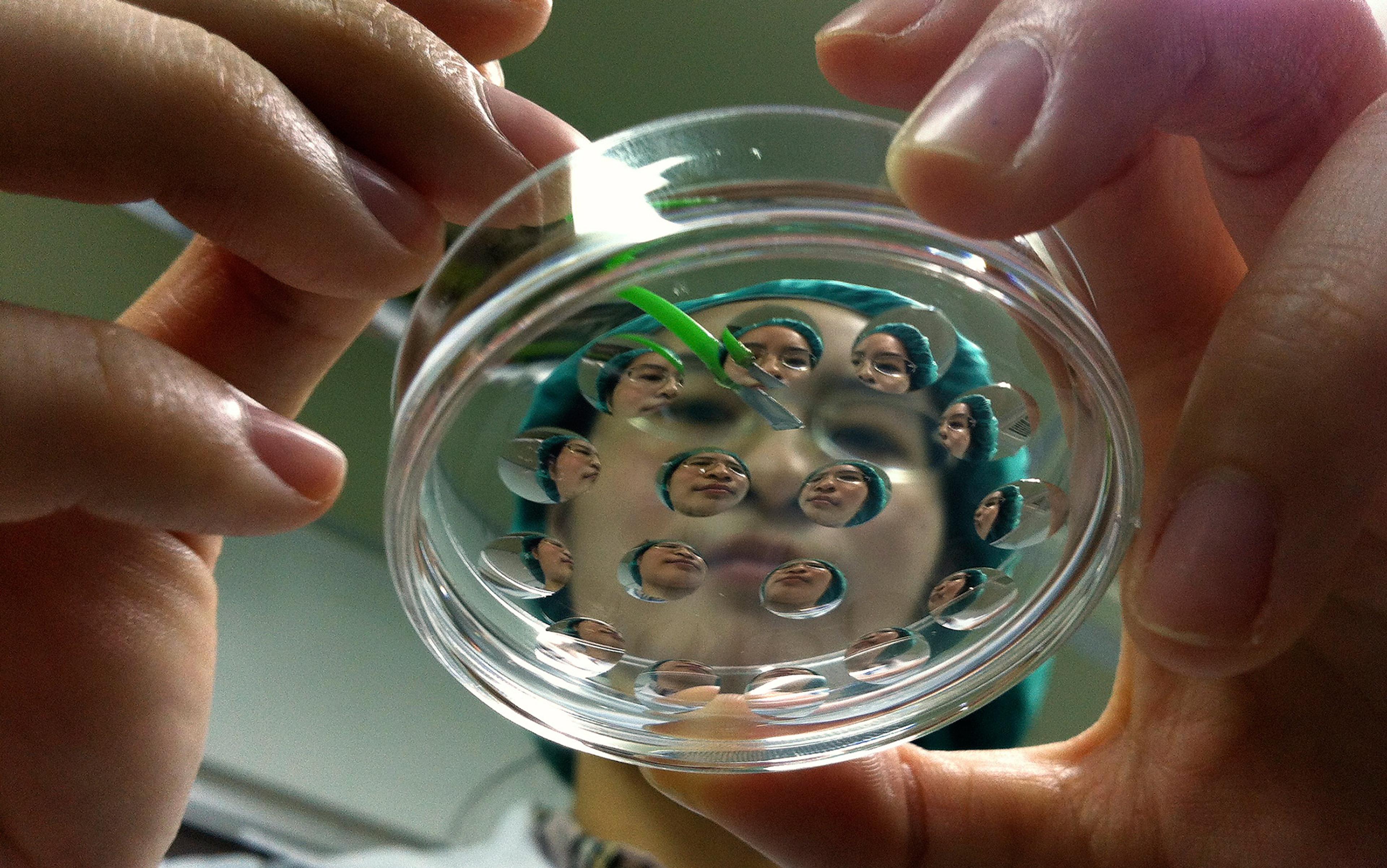In a popular article in Scientific American in 1955, at the dawn of the molecular genetic age, the Soviet defector, physicist and polymath George Gamow wrote: ‘Comparing a living cell with a factory, we can consider its nucleus as the manager’s office and the chromosomes as the filing cabinets where all the production plans and blueprints are stored.’ In May 2023, when Eric Green, director of the US National Human Genome Research Institute, announced the newly released human pangenome – a collection of genomes representing the spectrum of human diversity in aggregate – he described it as ‘providing an expanding view of humanity’s DNA blueprint’.
The ‘genetic blueprint’ is just one example of the rich linguistic vocabulary of the genome. The production of proteins from DNA is called gene ‘expression’ and involves the ‘transcription’ of the DNA ‘code’ into ‘messenger’ RNA, followed by its ‘translation’ into the sequence of amino acids that create a protein molecule. The blueprint idea implies that genes encode the general shape and function of the body, and that developmental differences from these encoded plans are perturbations or errors around a prior design or evolved intention. The genetic blueprint reinforces the idea that the answers to all interesting biological questions lie in our genes, and that other lines of research are either indirect or trivial.
In Who Wrote the Book of Life? (2000), the historian of science Lily Kay documented how linguistic metaphors in genetics morphed, during the mid-20th century, from descriptive analogies into scientific ‘ontologies’ – concepts about what genes really are, and what they do. These ontologies morphed from metaphors into specific concepts, and guided scientific research itself.
Since Gamow coined the genetic blueprint, however, we have learned an astounding amount about the developmental and physiological regulation of gene expression. In 1980, for instance, Christiane Nüsslein-Volhard and Eric Wieschaus discovered several entirely new classes of genes in Drosophila fruit flies that were later found to regulate development in all multicellular animal bodies from humans to horseshoe crabs. Their discovery initiated a new era of explosive research in molecular developmental biology, and they went on to win the Nobel Prize for Physiology or Medicine. We now understand that the embryonic development of the complex organs and the anatomical features of animal bodies involve detailed molecular conversations between cells and tissues through which cells and groups of cells establish their identities, achieve their complex morphologies, and establish their spatial and physiological relations. Although cells draw on genomic resources in this process, it is the molecules, cells, tissues and organs of the body that are the active agents in its material development.
It is hard to underestimate how revolutionary and unexpected Nüsslein-Volhard and Wieschaus’s discoveries were. Literally nothing about intercellular molecular signalling pathways and the expansive homology of developmental regulatory genes across all phyla of multicellular animals had been predicted by the previous eight decades of genetic and evolutionary research. Until the discovery of these genes and their function, no one knew that the same evolutionary patterns and molecular signals had been a reutilisation in the development of so many diverse cells types and body parts across so many species.
The idea of the genetic blueprint, and its underlying cybernetic definition of communication as the faithful exchange of information, prevented us from seeing the body as it really is – not the product of an algorithm, but a complex, molecularly networked social becoming. It is time to replace the genetic blueprint idea in light of contemporary developmental biology. But what alternative concept can both communicate the necessary complexity and foster productive scientific research? A surprisingly productive solution comes not from cybernetics, computer science or the theory of algorithms, but from the humanistic disciplines of the philosophy of language and feminist queer theory.
According to the blueprint idea, the body is a material realisation of a pre-existing, molecularly encoded, anatomical and physiological plan. In this view, gene expression constitutes what the 20th-century philosopher of language J L Austin referred to as a representational (or constative) speech act – an expression that describes, or refers, to something in the world, like the sentence Le chapeau de ma mère est sur la table (‘My mother’s hat is on the table’). In contrast, Austin also recognised performative speech acts, or statements that perform actions in the world – like the wedding vow ‘I do’, or the challenge ‘I bet you a hundred bucks that the Sox are going to win tonight.’ The difference between representational and performative speech is more than the difference between nouns and verbs. Verbs can refer to, or describe, actions, but performative speech is action – action in the social world.
Genes are not, and cannot be, the strict causes of the material body and its variations
In the 1960s and ’70s, Austin’s idea that language could both describe and act in the world had a profound impact on comparative literature, literary criticism and the humanities, playing a key role in philosophy and literary analysis. Unexpectedly, the same concept has the power to fuel a metaphoric revolution in molecular genetics, developmental biology, and evolutionary biology today.
Even casual consideration makes it clear that gene expression is not a material representation of a blueprint or plan. Rather, gene expression is action – a material doing by the cell. Gene expression creates material consequences. Enzymes catalyse molecular reactions. Hormones circulate systemically in the bloodstream, and bind to coevolved receptors, expressed only by certain cells. Paracrine signalling molecules diffuse from one cell to another, and likewise bind to coevolved receptors on the membranes of other, nearby cells. Upon binding, endocrine and paracrine signals can initiate cascades of gene regulatory changes within those cells. Transcription factors bind, or not, to coevolved promotor or enhancer sites on the DNA, leading to the upregulation, or suppression, of the expression of downstream genes.
In short, gene expression is performative, not referential. The body is not a representation of a genetic blueprint or algorithm. Rather, the biological individual uses its genome in the creation of itself – its material body. And because the actions of all these genes is contingent upon many other upstream and downstream molecular and cellular participants, genes are not, and cannot be, the strict causes of the material body and its variations. In an echo of Immanuel Kant, the organism is the cause of its own development and homeostasis.
Nowhere have the consequences of Austinian performativity been more elaborately investigated and powerfully applied than in the feminist discipline of queer theory – a field of philosophy and literary criticism that explores the nature and consequences of individual differences in gender, sex and gender identity. In this diverse field, the queer theory of gender performativity has specific and productive relevance to genetics, as well as to developmental and evolutionary biology.
In the 1980s, the feminist philosopher Judith Butler argued that gender is not synonymous with biological sex, nor a purely social construct, but a performative social action by individuals within their social environments. Accordingly, gender is a repeated set of social actions, and an individualised expression through doing – an act of self-becoming. In Butler’s words, gender performativity ‘carries the double-meaning of “dramatic” and “non-referential”.’
In Bodies That Matter (1993), Butler wrote that performativity is ‘that reiterative power of discourse to produce the phenomena that it regulates and constrains’.
Despite being a statement about gender performativity, it would be difficult to find a more concise and accurate description of the mechanisms of genetic action in bodily development. Take a glance at your hands. Their form, their parts, their hierarchically interconnected structures and their complex modes of function all reflect your individual history as a vertebrate animal, a mammal, a primate, an ape, a human being, and the child of your parents. Your hands also embody specific aspects of your lived experience in an environment, perhaps as a manual labourer (callouses), an office worker (carpal tunnel numbness), a weekend gardener (rose thorn scratches, and soil under the nails), or the pursuit of a specific gender aesthetic (manicured and painted nails). Your hands might resemble those of your parents in specific ways, but you didn’t inherit your hands from your parent’s hands. Rather, like an individual’s gender, every pair of hands is an iterative realisation of this complex morphology.
Our bodies are material iterations of a human being. But how? Through the scientific revolution instigated by Nüsslein-Volhard and Wieschaus, we now know that our complex bodies develop through the exchange and management of intercellular signals – in an elaborate, intercellular molecular discourse.
Text messages among teens are like those cell-to-cell (or paracrine) signals
Why discourse? In the humanities, the term discourse describes the way in which modes of structured communication create and constrain what it is possible to communicate; what kinds of communications have value, meaning or consequence; who is authorised to be a legitimate speaker or receiver; and how those constraints contribute to identities and boundaries. The humanistic concept of discourse captures the fact that the molecular signalling among the cells of the body is highly structured. Most cells are both producers and receivers of chemical signals. Cells are capable of attending to specific signals, or not, depending upon what receptor proteins they express. The process of developing from a generalised state of open possibilities – such as an embryonic epidermal skin cell – to a specific developmental state – like a hair, sweat gland, or nail cell – involves the individuation of discourses among groups of socially interacting cells.
Imagine what happens as an American teenager prepares for the weekend ahead. On Wednesday night, she receives a text from a friend with a proposal to go to a new movie on Friday night. ‘Awesome!’ is the response. Soon, other friends are recruited by additional texts to the same collaborative project, or developmental fate. By Thursday night, however, after the group has grown in size, and other interactions have occurred during the school day, more texts go out expressing problems or alternatives. ‘That movie sucks!’ That person ‘dissed me’. Or ‘My parents will be out of town, so I am having a party!’ By Friday morning, the social group has fissioned, several alternative possibilities have been envisioned, additional new individuals have been recruited, and each individual must decide to pursue a specific activity, which precludes the others. In parallel, the group texts have also channelled into separate discussions with fewer or no overlapping individuals. At school on Friday afternoon, the principal gives an announcement over the intercom admonishing all students to summon their best behaviour for the upcoming homecoming weekend, and sends an identical email to all students. By the time Friday evening arrives, all the parents in all the families are inevitably trying to figure out where the hell their children are.
The text messages among teens are like those cell-to-cell (or paracrine) signals. The principal’s announcements and emails act like widely broadcast hormones (or endocrine signals). The effectiveness of either in influencing a specific teen’s behaviour depends on a balance among all incoming messages, their relationships with other signallers, and whether anyone is even listening. Each teen brings their own individual agency to these interactions, but none is entirely free from social influence, and decisions are made in common with multiple others in likeminded associations or cliques. In summary, highly structured, molecular discourses lead to the development of cellular identities with distinct morphologies, anatomical boundaries and physiological functions. The context-dependent admission and exclusion of certain signals allow groups of cells to co-organise themselves into coherent, anatomically nested and functionally integrated tissues and organs of the body. Being a specific neuron, muscle cell or liver cell is always preceded by the discursive establishment of a cell identity in social collaboration with other cells.
Of course, cells take material actions through their gene expression, morphologies and functions. Becoming a specific kind of cell means expressing certain structural proteins – bricks and mortar, if you will – of that cell type. But the majority of genes involved in development are actually involved in the regulation of the intercellular and intracellular discourses that contribute to the decision to become a specific cell type, and to express the appropriate structural proteins. Thus, the primary goal of molecular discourses during development is to ‘regulate and constrain’ the process itself. Ultimately, expression is performative – according to dialogue and need, and not by code or algorithm.
It is time to abandon the genomic blueprint and embrace the performative body – our performative bodies. Gene expression is action within the diverse, anatomically structured social milieu of the trillions of cells of the human body. The genome is not the cause of the body, but a historically derived set of lexical resources to be used by the cells and tissues of the body in their discursive realisation of the self. In short, we are performance all the way down.
With its catchy, intellectual mouthfeel, the word ‘performative’ has recently moved from the obscurity of queer theory into contemporary lingo and anti-woke critique. But the popular connotations of the term to mean false, inauthentic, shallow or just-for-show do not communicate its original meaning of ‘non-representational expression as social action’. Indeed, because we are performance all the way down, there is nothing else that we really are. Thus, performativity does not imply inauthenticity; it implies individuality enacted in an environment through social discourse.
But who is doing all that performing? Butler wrote that ‘performativity implies agency’. Likewise, the performativity of the body means that hormones, cell-to-cell signalling molecules and their receptors, transcription factors and their binding sites, cells, signalling centres, tissues and glands all have evolved agency – that is, capacity for action that is contingent upon the prior history of selection on their functions. For example, a hormone cannot cause any cell to do anything. To be receptive to any hormonal signal, a cell must first express the corresponding, coevolved receptor for that hormone. Thus, cells have the developmental agency to tune in, or tune out, the molecular signals produced by other cells and glands within the body. The active, environmentally contingent participation of hundreds of cell types in the body’s development and physiology are evidence of their evolved agency, not of a blueprint encoded in their shared genomes.
This talk of molecular and cellular agency might sound outlandish, but remember that, for nearly 50 years, biologists and the public have become perfectly comfortable with Richard Dawkins’s concept of the ‘selfish gene’. What does such ‘selfishness’ mean in this context if not the evolved agency to pursue one’s goals and interests? Of course, the agency of genes feels intellectually comforting to many because it reinforces the reductive power of the genetic blueprint. But the evolved agency of genes does not negate or deny the agency of proteins, gene-binding sites, cells, tissues and organs. The performative biology I am proposing requires merely expanding that agency to encompass other biological molecules, cells, tissues and organs – the entities that actually do everything in biology.
Not surprisingly, given the focus of queer theory on variations in human gender, the performativity of our material bodies has no more profound implication than in the consideration of individual human sex. As the literary scholar Eve Kosofsky Sedgwick wrote in Touching Feeling (2003), performativity is anti-essentialist. Once we recognise the power of discourse – whether it is verbal, gestural, textual or molecular – to make and to affect reality itself, we realise that such discourses do not, and cannot, represent any prior, individual essence.
Thus, individual sex is not an essential scientific fact about a fertilised egg, an individual cell, or a specific combination of chromosomes, genes or hormone levels. Like the material body itself, individual sex – the anatomical and physiological capacities to reproduce in particular, structured ways – is a becoming, an individual realisation that unfolds during life through the doing of life.
Sexual development involves the use of our genes, but is not defined by them. Instead, the functions of specific chromosomes, genes, hormones, signalling molecules and receptors in human sexual development are each contingent upon many other, upstream and downstream players in the embodied, molecular/material discourse of sexual development.
For example, the SRY gene – short for ‘Sex-determining Region on the Y’– has been referred to thousands of times in the scientific literature as the ‘master switch’ of mammalian sex determination. SRY is a transcription factor that binds to an enhancer upstream on the DNA of the SOX9 gene, another transcription factor that, among many functions in the body, can play a role in testis development within the embryonic gonad.
However, this ‘master switch’ is not the master of anything. In fact, SRY is mess! In a paper with the ironic title ‘SRY: The Master Switch in Mammalian Sex Determination’ (2010), the developmental biologists Kenichi Kashimada and Peter Koopman describe SRY as ‘a fragile and partly debilitated gene’ in a ‘degraded state’. In another paper entitled ‘SRY and the Hesitant Beginnings of Male Development’ (2007), Juan Carlos Polanco and Koopman further write: ‘[I]nstead of the robust gene that one might expect as the pillar of male sexual development, SRY function hangs by a thin thread.’ (They never explain why one would expect male sexual development to require a ‘pillar’ in the first place.)
SRY’s precarity demonstrates that evolution itself is generatively queering
Like the trope of the fragile male ego, the molecular development of mammalian testes appears to be intrinsically precarious. All of this biomedical anxiety about the molecular impotence of the mammalian sexual ‘master switch’ comes from the volumes of real data documenting the numerous hurdles SRY must overcome to perform its simple and singular function – turn on the SOX9 gene in the developing gonad. After transcription, SRY messenger RNAs must first be stabilised by the WT1+KTS protein isoform until they can be translated into a protein. Then, the SRY protein must be phosphorylated in one spot, acetylated in another, and bound to two other chaperone proteins – calmodulin and importin-β – before it can move into the cell nucleus. Once there, it must unbind calmodulin and importin-β, and then bind to a specific ‘ACAA’ amino acid sequence in the minor groove of the DNA upstream of SOX9, and bend the DNA to a 60˚-85˚ angle to turn on SOX9 expression.
However, every single one of these events can be disrupted. We know this through the genetic investigation of individuals who were raised as girls but unexpectedly never reached puberty, and were found to be XY individuals without testes. The molecular hurdles that SRY faces in performing its function are not honest handicaps designed by evolution to ensure that only the best embryos get to become male. Rather, each of these events evolved to compensate for another novel and deleterious mutation that arose in SRY during its long evolutionary history on the lonely, un-recombining Y chromosome. And each and every baroque compensation for SRY’s functional problems becomes another contingent, discursive dependency leading to ever-richer opportunities for the origin of developmental differences in embodied sex. SRY’s precarity demonstrates that evolution itself is generatively queering.
Many more examples of differences in human sexual development demonstrate that SRY is neither necessary nor sufficient for testis development, or the establishment of anatomical maleness. Molecular developmental biology demonstrates that sex is not a scientific fact about a zygote, a cell, a gene or any chromosomal combination. Nothing can ‘determine’ or define individual sex other than its achievement. Individual sex is a becoming. To paraphrase Simone de Beauvoir, at the molecular, cellular and cultural level, ‘To be a woman (or a man), is to have become one.’
The implications of all this are profound. Differences in sexual development among individuals – including what are often referred to as intersex conditions – are not examples of a sexual binary gone wrong, but evidence that there isn’t an individual sexual binary in the first place. If individual sex is not a genetically defined essence – an inherent and indispensable fact etched in our genomes – then there is no individual sexual essence to be abandoned, or to be adopted, through trans experience. Nor is there any sexual essence to be defended within cis experience. All of our sexual bodies are enacted through an individualised process of performative becoming. That is what it means to live in a body. Trans experience is just a more complicated becoming.
The performativity of our bodies extends beyond gender/sex to every aspect of our biology. Despite decades-long efforts to reduce human complexity and diversity to our genomes, science keeps reconfirming the importance of our individuality. All of our diverse and complex traits – from intelligence and athletic, linguistic or musical abilities to our risk of complex diseases, like cancer and heart attack – are best understood as aspects of our performed selves. The genetic inputs on such complex traits are highly diverse, involving interactions among many rare variations of many genes. Consequently, when biologists identify all the heritable genetic variations that affect the risk of heart attack, we can explain less than 10 per cent of it. This ‘missing heritability’ demonstrates that we humans are overwhelmingly genetically variable. It means that the genetic contributions to your risk of heart attack or cancer are the result of gene-by-gene-by-gene… interactions that are virtually unique to you. The consequences of these myriad genetic variations manifest precisely within the complex ways that we develop individually – our complex, discursive becomings. Through the enormous effort to uncover the universal human genetic blueprint – including the most recent pangenomic edition – science has instead revealed our overwhelming, stubbornly persistent human individuality.
Biology needs queer theory to get the body right
All of the most complex and distinctive innovations as human beings – our creative intelligences, our diverse personalities, our rich psychological capacities, and our facility for language – are examples of performative evolutionary novelties. In the same way that gender performativity identifies the role of agents in our social environment in our gender becomings, human psychology, intelligence and language capacity all arose through coevolutionary feedback between our developing brains and our increasingly complex social environments, which cannot be encoded within our genomes. Our sensory and subjective experiences are not projections of data onto neural algorithms, but dynamic actions taken by every individual in interaction with the world. More than any other aspects of the human phenotype, human psychology, personality and behaviour are explicitly Austinian performatives – doings in our social world.
The performative understanding of our physical bodies and minds provides a single, unified conceptual framework for simultaneous science-culture enquiry and dialogue about evolution, biology, genetics, psychology and gender/sex. This shift in scientific thinking is not an accommodation to culture but, rather, an improvement in scientific understanding in its own right. Biology needs queer theory to get the body right. Although some may find this surprising, it means simply that scientists can learn about science from people who are not scientists.
Performative biology establishes an intellectually queer space in the heart of molecular genetics, developmental biology and evolutionary biology. Scientifically, performative biology calls for a renewed focus of biological research on all levels in the complex hierarchical process of organismal development and evolution, not just on genes. But this metaphoric revolution will require some fundamental rethinking about how biology is taught, researched and funded. Performative biology also extends an invitation to develop new directions and priorities in scientific research, by new generations of researchers, conceived in the fact that organisms are complex, individual becomings, not material products of a blueprint. Lastly, performative biology establishes an intellectual path for queer and trans scientists and their allies to pursue scientific research in molecular biology, developmental biology, evolutionary biology and psychology in ways that connect personally and intellectually to their lived experiences and identities.






